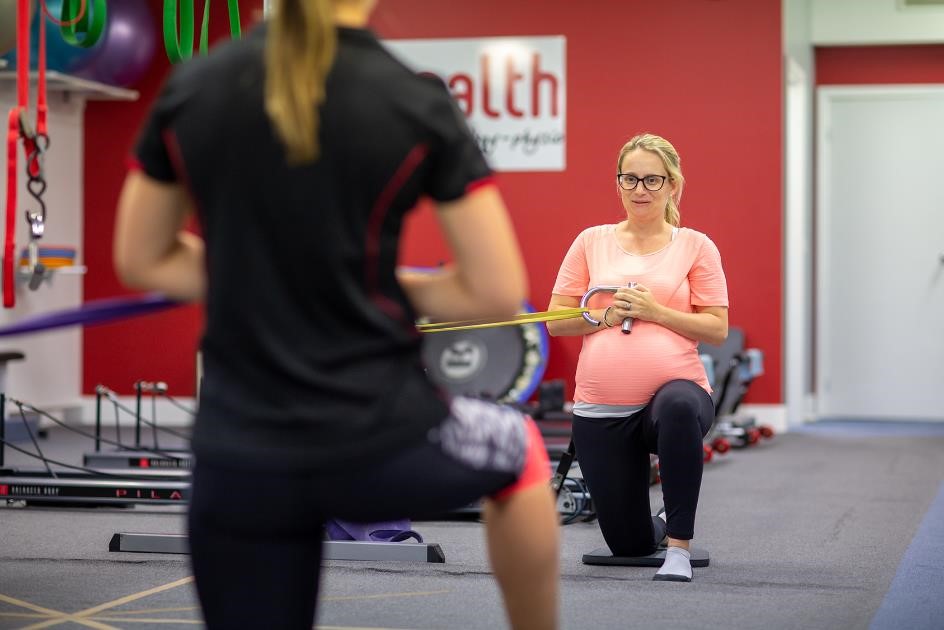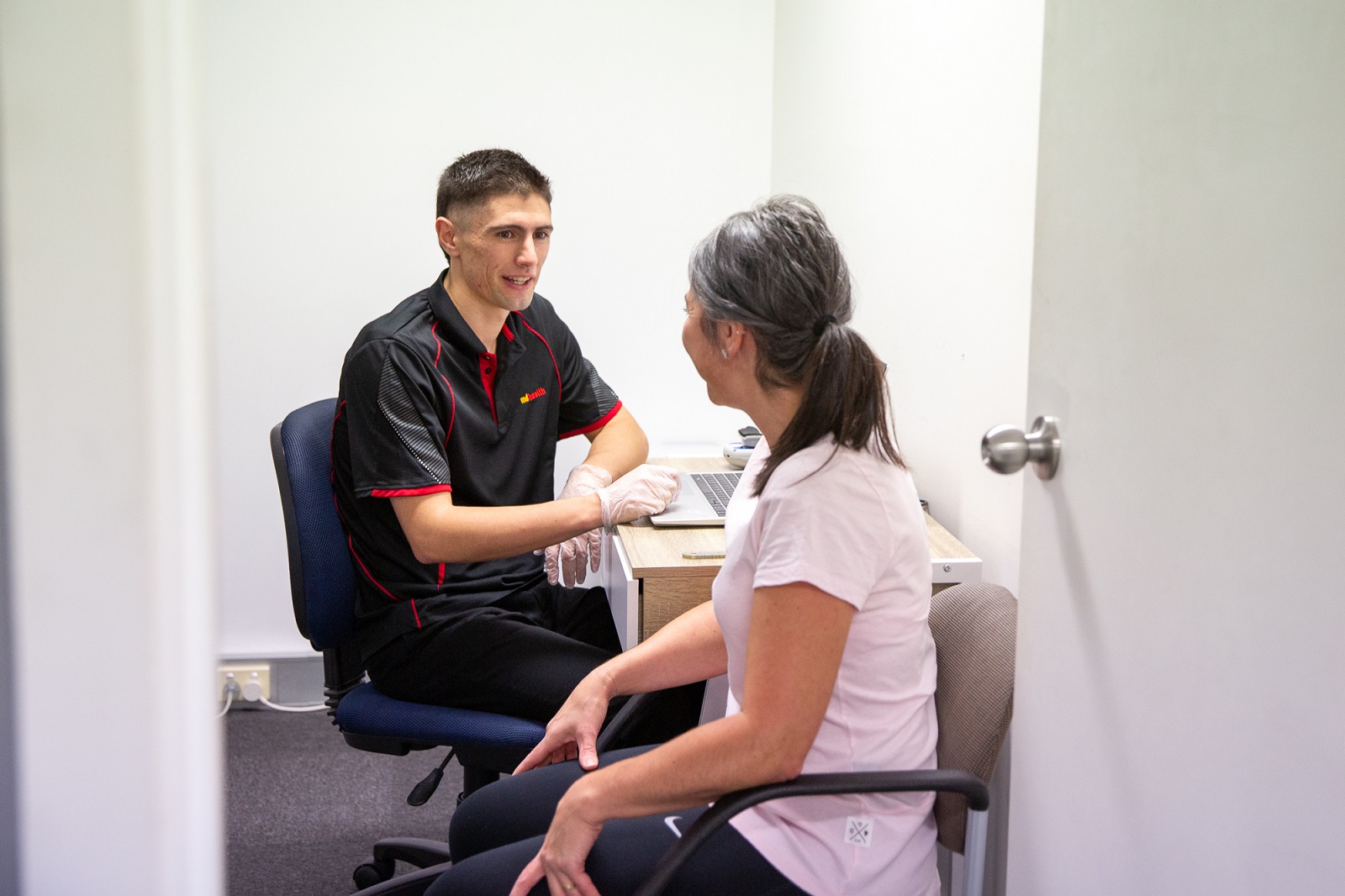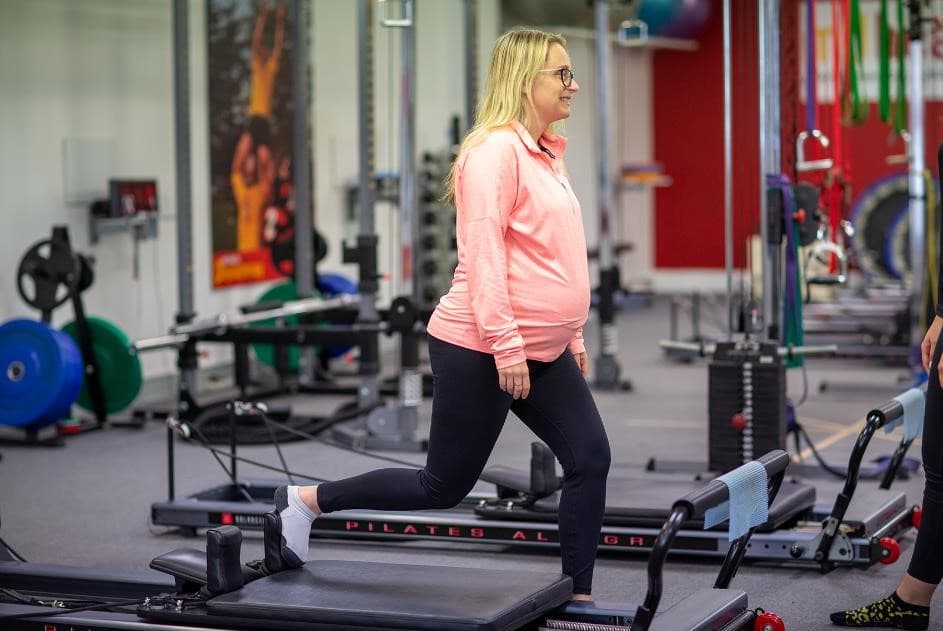If you’re expecting a baby, you may be curious about what kinds of physical activity are good for you and your little one. One great option to consider is pregnancy Pilates.
This friendly and informative blog post will describe why it’s a good idea to do Pilates while pregnant,
- When to start
- How to adjust your routine as your body changes throughout each trimester.
Well, let’s just jump right in!
Benefits of Pilates during pregnancy
During pregnancy, a lot is happening physiologically as your body grows a human. Your blood volume, heart rate and cardiac output all increase, which can leave you feeling short of breath.
Not only can Pilates aid in being able to cope with the chnges in your body durig pregnancy (including improved control around your pelvis and upper body posture), but also in postpartum recovery,
By focusing on the abdominals, back, and pelvic floor, prenatal Pilates increases your body awareness and prepares you for pushing. It can also decrease back pain and improves your sleep.
Plus, it can build the stamina you’ll need for the mental and emotional strength required during labor and delivery.
Whether you were previously sedentary or an avid exerciser, studies have shown that Pilates can be incredibly beneficial during pregnancy.
When to start Pilates during pregnancy
This a very simple answer, the earlier the better. If you have been doing Pilates prior to conception, great, just keep going. If you have just found out you are pregnant and want to start, as long as you feel up to it (in the early stages, due to morning sickness, you may not feel like starting yet) you can start.
The earlier you start, the earlier you can start seeing the benefits of improved strength and control around your hips and pelvis, your pelvic floor muscles and your upper body posture.
When is it too late to start Pilates during pregnancy
The recommendation is usually not to start a new exercise program after 20 weeks. At this stage, your body has already made the changes associatd with pregnancy (which are very similar to the changes associated wth exercise training) and adding the additional load of exercise training is not recommended. For further details, check out the Amercian College of Sports Mediicine’s guide to Pregnancy Physical Activity

What you will need to do before starting pregnancy Pilates
Before starting Pilates during pregnancy, it’s essential to consult with a healthcare professional to ensure it’s safe for both you and your baby. Before you start your program, the Pilates facility should request that your obstetrician fill out a specific clearance form looking for absolute and relative contraindications to exercise to ensure you are safe to exercise. Most women will be okay, but there are certain medical conditions that need to be respected during your pregnancy and they must be cleared before exercising. For more details of when it is unsafe to exercise, click on American College of Obstetricians and Gynecologists exercise during pregnancy
Once you’ve been given the green light, it’s important to have a physical assessment by a qualified instructor, such as a physiotherapist. exercise physiologist or osteopath to understand your strengths, weaknesses and where you will gain the most benefit from your Pilates program.
These professionals have extensive knowledge and training in human movement and biomechanics, which will help them identify any muscle imbalances or weaknesses that may need to be addressed during your Pilates practice.
In addition to the physical assessment, it’s great idea to have a pelvic floor assessment by a qualified women’s health physiotherapist.
These professionals have the necessary expertise to ensure that your pelvic floor muscles are functioning optimally.
This assessment is particularly important during pregnancy, as the weight of the growing baby can place additional strain on these muscles, increasing the risk of issues such as incontinence or pelvic organ prolapse.
By engaging with qualified instructors, you can ensure that your Pilates practice is tailored to your unique needs and pregnancy stage.
They can develop a customized program that promotes proper alignment, targets specific muscle groups, and minimizes the risk of injury.
With their guidance, you can safely engage in Pilates exercises that help you maintain your strength, flexibility, and overall well-being throughout your pregnancy journey.

Trimester-specific guidelines
Each trimester presents unique challenges and considerations for practicing Pilates. Here’s a breakdown of what to expect during each stage:
First Trimester
During this initial phase, your body is working hard internally to prepare for the baby. You may experience fatigue, nausea, or both. It’s essential to listen to your body and avoid overexertion.
Strengthening the backside of your body (glutes and hamstrings) can help counteract any anterior pelvic tilts that may be occurring. Remember to pay attention to your range of motion and avoid pushing your joints too far.
Proper alignment
Paying attention to your alignment during exercises can help prevent undue stress on your joints and muscles.
Prioritize maintaining a neutral spine and proper head, shoulder, and hip positioning in your Pilates practice.
This attention to alignment will help support your changing body and minimize discomfort as your pregnancy progresses.
Pelvic floor strengthening
The pelvic floor muscles play a critical role in supporting the weight of your growing baby and preparing for childbirth.
Strengthening these muscles can help prevent issues such as incontinence and pelvic organ prolapse.
Incorporating exercises that target the pelvic floor, like Kegels, into your Pilates routine is essential on this stage.
During this trimester, continue to listen to your body and avoid overexertion. It’s essential to find a balance between strengthening the pelvic floor and allowing your muscles to relax.
Second Trimester
As your growing baby and shifting centre of gravity present new challenges. Minimize lying on your back, as it can compress major blood vessels and restrict blood flow to you and your baby.
Focus on seated or side-lying exercises to maintain strength and stability.
In this feel-good stage, balance, endurance, and coordination are tested. Modify exercises using supportive props, elevating the reformer, and performing side-lying exercises.
Avoid full planks and forward-flexing abdominal exercises, as they contribute to diastasis recti and increased pelvic floor pressure.
Third Trimester
In the third trimester, energy levels may decline as your bump grows. Continue following second trimester guidelines, with an emphasis on birth preparation.
Focus on contraction work, reverse Kegels, and maintaining a full range of motion in your movements.
Your growing bump can affect your posture, leading to exaggerated spinal curves, rounded shoulders, and lower back lordosis.
Prioritize Pilates exercises that open the front of the body and strengthen the back.
Gentle mobility and stretching may provide the most benefits during this stage.
Remember not to pressure yourself to achieve fitness goals, as your body is already preparing for the significant event of childbirth.

When to stop doing Pilates for pregnancy
Most women can continue to exercise up until term, however, your body s a very important guide of when to stop. If you feel energised from your workout and still feel good, you can keep going. However, when you feel exhausted after your session and really feel tired after working out, it is your body’s way of telling you to stop. This point can often happen anywhere from 32 weeks to term and is very dependant on the women.
If you have been told by your obstetrician to stop exercising because you have developed an absolutre contraindication to exercise during your prgnancy (eg preeclampsia), it is extremely for you to stop, for your safety and the safety of your baby.
Types of Pilates suitable for pregnancy
Reformer Pilates is an excellent option during pregnancy, as it allows for a wide range of modifications and supports to accommodate your changing body.
The reformer machine provides gentle resistance, helping you to build strength without straining your muscles or joints.
However, it’s essential to avoid hot Pilates and exercises in the supine position after the first trimester. Hot Pilates, or practicing Pilates in a heated room, can cause your body temperature to rise, which may be harmful to your baby.
Similarly, supine exercises should be limited or avoided altogether due to the potential for reduced blood flow.
Conclusion
In conclusion, pregnancy is a unique and transformative time in a woman’s life, and Pilates can be an excellent way to support your changing body throughout this journey.
By consulting with a healthcare professional, having a posture and pelvic floor assessment, and following trimester-specific guidelines, you can safely and effectively incorporate Pilates into your pregnancy fitness routine.
Remember to listen to your body and make modifications as needed to ensure a safe and enjoyable Pilates experience for both you and your baby.
At MD Health, our team of dedicated professionals is here to guide and support you on your pregnancy Pilates journey.
Don’t hesitate to reach out to us for personalized advice, assessments, and tailored Pilates programs to suit your specific needs during this special time in your life.
We look forward to helping you feel strong, confident, and prepared for the exciting journey of motherhood ahead!
Do you have any questions?
Call us on (03) 9857 0644 or (07) 3505 1494 (Paddington)
Email us at admin@mdhealth.com.au
Check out our other blog posts here
Our clinical staff would be happy to have chat if you have any questions.
Take the first step to a healthier you!
Would you prefer for someone to contact you to book your FREE Full Body Assessment*?
Please fill in this form and someone from MD Health will be in touch with you soon.
Alternatively please call us on:
07 3505 1494 (Paddington – Brisbane (QLD) Clinic)
Or email us:
admin@mdhealth.com.au (VIC) paddington@mdhealth.com.au (QLD)
*Please note only the Full Body Assessment is a FREE service. The Full Body Assessment is for new clients at MD Health or returning clients who haven’t been in for 6 months or longer who intend to particpiate in our 13 Week Clinical Pilates Program**.
For all new clients who wish to come in for a one-off, casual or adhoc basis for Physiotherapy or Exercise Physiology the Initial Physiotherapy or Initial Exercise Physiology appointment is a paid service.
** The 13 Week Clinical Pilates Program at MD Health is not a lock in contract and you are not required to attend for the full 13 weeks if you do not wish.
This site is protected by reCAPTCHA and the Google Privacy Policy and Terms of Service apply.



